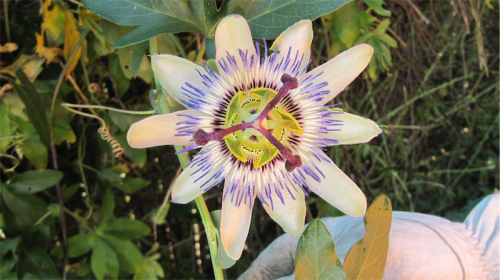It easily escapes from gardens bordering bushland through its suckering habit and it’s time the ACT government took action to include it on the environmental weeds list.
The most popular variety of passionfruit is Nellie Kelly, grown by Kelly’s Nursery in Victoria, and is considered the best variety for Canberra.It is a grafted passionfruit on to wild passionfruit rootstock but if the grafted top part dies the wild rootstock will take over – and I mean take over – spreading rapidly through the garden and everywhere else!
The fruiting Nelly Kellie passionfruit has a large, glossy leaf, but the wild rootstock has (as illustrated here) a five-fingered dull green leaf. It may still have amazing flowers but these do not produce fruit.
Once the wild rootstock gets a hold it is almost impossible to eradicate as hundreds of suckers spread easily to all parts of the garden. It can develop a trunk as thick as a human wrist and I have seen it grow to the top of gum trees.
Cutting the main stem and treating it with undiluted glyphosate will not stop subsequent suckers growing.
TO win a gold medal at the Royal Horticultural Society’s Chelsea Flower Show in the UK is quite something. But for an Australian team, under Phillip Johnson, to win the Best in Show award last year was amazing. For the last few years Fleming’s Nurseries, of Victoria, has sponsored aspiring garden designers at the world’s greatest flower show, Chelsea, and have previously won gold medals.
Inevitably Phillip has become an international name in garden design and, unsurprisingly, his first book has followed. Titled “Connected” (Murdoch Books, rrp $59.95), it is an inspiration to all new garden designers or those who want to design their own garden.
“In this day and age we are becoming more and more detached from nature,” he writes.
“We’ve forgotten how healing it is to be surrounded by beauty. Connecting with the earth is one of the most invigorating and energising things you can do.”
His gardens range from small suburban gardens to large rural properties and this book, with great photography and watercolour drawings of plans, is one of the best on the subject I have seen.
Jottings…
- Remove all winter crops in the veggie garden such as broad beans after harvesting.
- Hopefully there will be no more frosts, so get on with planting/sowing silverbeet, sweet corn, cucumber and tomatoes.
- Unlike most other plants, when planting tomatoes, bury it halfway up the stem. Those tiny hairs will all put out roots for a stronger plant.
- Plant citrus trees either in the garden or in containers (hints at cedricbryant.com, click on ‘Cedfacts’).
- Lightly trim all evergreen shrubs after flowering. Not more than one third off at any time, particularly important with Australian plants.
- Continue to feed all plants with organic plant nutrients. Apply to the drip line and keep away from the trunk/stem of the plant.
- If you see evidence of pear and cherry tree slug, a non-chemical fix is to throw fine sand all over the tree. The slugs stick to the sand and fall off.
The post Gardening / The scary truth of passionfruit appeared first on Canberra CityNews.

